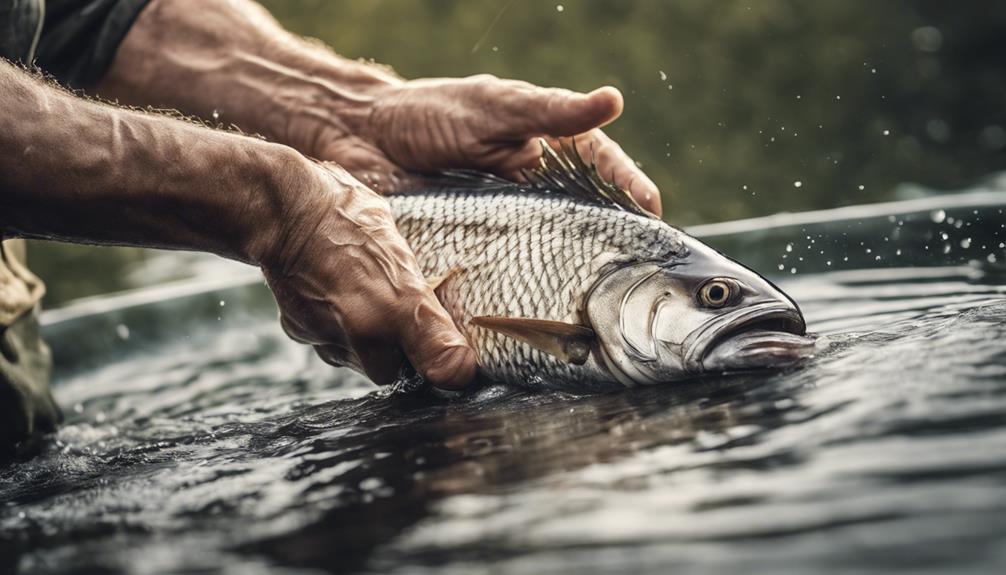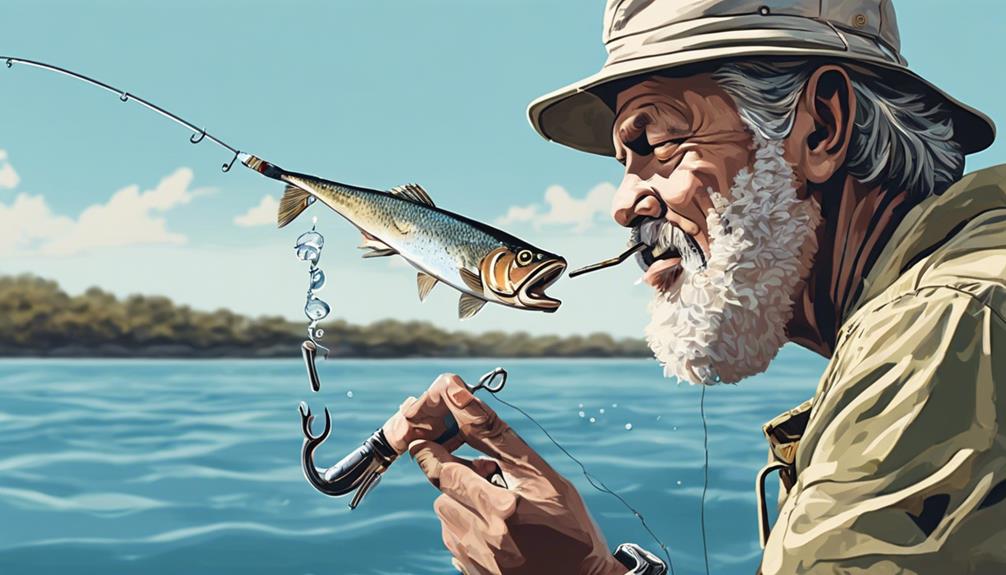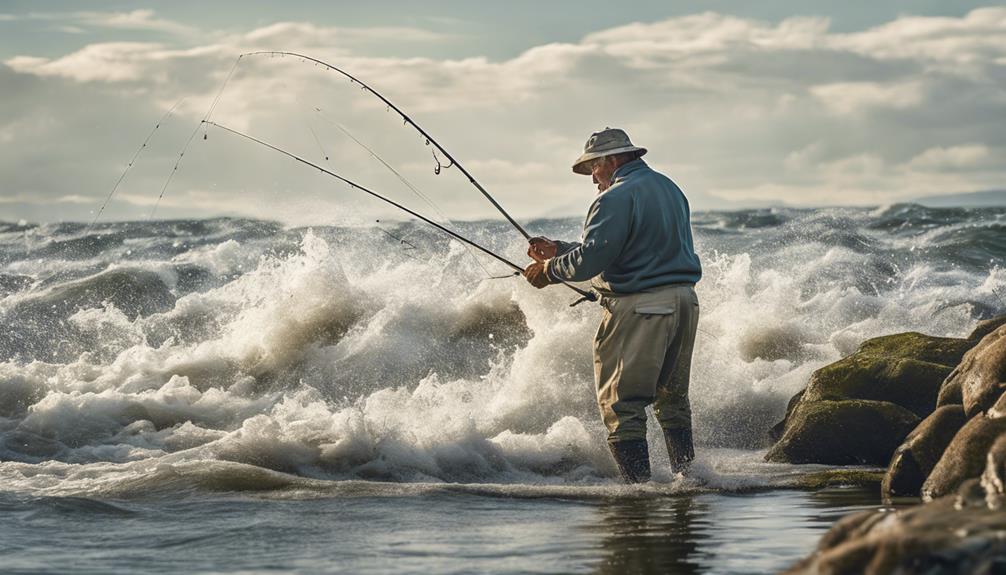Imagine standing knee-deep in a serene river, the early morning mist rising gently around you as you prepare to cast your line.
As you feel the tug on your rod, mastering the art of catch and release fishing becomes a gratifying challenge.
But, have you ever wondered how to perfect your techniques to ensure the fish's survival after the release?
Understanding the intricacies of handling, hook removal, and fish behavior can significantly impact the fish's well-being post-release.
Selecting the Right Gear
When gearing up for catch and release fishing, make sure you select the appropriate gear to ensure a successful and ethical experience. Gear selection plays a crucial role in the well-being of the fish you catch. Opt for barbless hooks to minimize harm and make hook removal easier. Choose tackle options like circle hooks, which are known for hooking fish in the lip rather than deep in the throat or gut, increasing their chances of survival after release.
Consider using artificial lures instead of live bait to reduce the chances of deep hooking. Artificial lures often result in better hook placement, making it easier to unhook the fish quickly and safely. Selecting the right gear also extends to your choice of fishing line. Use a strong, yet lightweight line to minimize exhaustion for the fish during the fight. This reduces stress on the fish and improves its chances of swimming away healthy upon release.
When it comes to gear selection, prioritize the well-being of the fish. By choosing the right tackle options, such as barbless hooks, circle hooks, and artificial lures, you can enhance the chances of a successful catch and release. Remember, the goal is to enjoy the sport of fishing while respecting the environment and the fish you encounter.
Proper Hook Removal Techniques
Consider using a pair of needle-nose pliers to gently and efficiently remove the hook from the fish's mouth, ensuring minimal damage and a smooth release process. Proper hook handling is crucial for fish health and overall survival post-release. When extracting the hook, make sure to approach the fish calmly and with steady hands to minimize stress.
To begin, firmly grip the shank of the hook with the needle-nose pliers, positioning the tool as close to the fish's mouth as possible. Next, gently rotate the hook to loosen it before carefully pulling it out in the direction it entered. This technique reduces the risk of causing further harm to the fish and increases the chances of a successful release. Remember, swift and precise hook extraction is key to ensuring the fish's welfare.
It is essential to assess the hook's location in the fish's mouth before attempting removal. If the hook is deeply embedded or in a sensitive area, such as near the gills, consider cutting the line as close to the hook as possible instead of trying to remove it forcefully. This decision may increase the fish's chances of survival by avoiding unnecessary harm. By mastering proper hook removal techniques, you contribute to the well-being of the fish population and promote sustainable catch and release practices.
Handling and Releasing Fish Safely
To ensure the well-being of the fish post-hook removal, mastering proper handling and releasing techniques is crucial. When handling fish, always wet your hands before touching them to avoid damaging their protective slime layer, which is essential for their health. Supporting the fish gently but firmly is key; ensure you don't squeeze them too tightly. If you need to lift the fish, do so horizontally to prevent injury.
When it comes to release methods, timing is crucial. Revive the fish by gently moving it back and forth in the water to allow oxygen to flow over its gills. Ensure the fish swims away on its own; don't push or throw it back into the water. If the fish appears lethargic, consider holding it upright in the water to help it recover.
Understanding Fish Behavior
To understand fish behavior effectively, observe their movements in different environmental conditions. Fish feeding habits can vary depending on the time of day and the availability of food sources. In the early morning, you may notice fish actively feeding near the surface as they search for insects or small baitfish. During midday, fish might move to deeper waters or seek shelter in shaded areas to avoid predators. Understanding these patterns can help you anticipate where the fish will be located, increasing your chances of a successful catch.
- Fish Feeding Patterns: Pay attention to how fish feed in different conditions, whether they're bottom feeders, surface feeders, or mid-water feeders.
- Underwater Habitats: Explore the diverse underwater habitats where fish seek refuge, such as rocks, submerged vegetation, or underwater structures like sunken logs.
- Temperature and Oxygen Levels: Note how fish behavior changes with fluctuations in water temperature and oxygen levels, as these factors influence their metabolism and movement patterns.
Using Barbless Hooks Effectively
After understanding fish behavior and their preferred habitats, mastering the use of barbless hooks effectively is crucial for successful catch and release fishing. Barbless hooks offer several benefits that aid in the safe release of fish back into the water. One of the main advantages of using barbless hooks is that they cause less damage to the fish's mouth compared to barbed hooks, making it easier to unhook the fish quickly and with minimal harm.
When using barbless hooks, it's essential to focus on the proper technique to ensure a successful catch and release. The key is to maintain steady tension on the line throughout the fight with the fish. By keeping the line taut, you can prevent the fish from shaking its head vigorously, reducing the risk of the hook coming loose prematurely. Additionally, when reeling in the fish, try to avoid any sudden movements that could potentially dislodge the hook.
Best Practices for Landing Fish
Mastering the best practices for landing fish is essential for successful catch and release fishing. When it comes to ensuring the fish's well-being and the overall effectiveness of your fishing experience, paying attention to catch size and perfecting your landing technique are crucial.
Here are some key tips to help you improve your fish landing skills:
- Catch Size: It's important to match your tackle to the size of fish you're targeting. Using appropriate gear for the fish species you're after won't only make the fight more enjoyable but also increase the chances of successfully landing the fish.
- Landing Technique: When reeling in a fish, avoid jerking the rod or applying excessive pressure. Instead, maintain a steady tension on the line and guide the fish towards you smoothly. Be patient and allow the fish to tire itself out gradually before attempting to bring it closer to the shore or boat.
- Mindful Handling: Once the fish is within reach, handle it with care. Wet your hands before touching the fish to protect its slime layer, which is important for its health. Use barbless hooks to facilitate an easier and safer hook removal process, minimizing potential harm to the fish.
Minimizing Fish Stress During Release

When releasing a fish back into the water, focus on minimizing stress to ensure its survival and well-being. Proper fish handling is crucial in reducing stress during release. Avoid touching the fish with dry hands as it can damage their protective slime coat, making them more susceptible to infections. Wet your hands before handling the fish or use a rubberized landing net to minimize direct contact.
Utilize proper release strategies to minimize fish stress further. Keep the fish in the water as much as possible, only lifting it for a quick photo if necessary. Avoid squeezing the fish or putting excessive pressure on its body. Support the fish gently and avoid dropping it back into the water from a height.
Quickly remove the hook using proper tools to minimize handling time. If the fish is deeply hooked, cut the line close to the mouth instead of trying to retrieve the hook, as this can cause more harm. Allow the fish to swim away on its own accord; don't push or throw it back into the water.
Ensuring Proper Revival Techniques
To ensure the fish's successful revival after release, focus on gentle handling and implementing proper techniques to support its recovery in the water. When reviving fish, remember the following:
- Hold the fish upright: Gently support the fish in an upright position underwater to help it regain its equilibrium. This position allows water to flow through the fish's gills, aiding in oxygenating its system.
- Move the fish back and forth: Slowly move the fish back and forth in the water to help water pass over its gills. This movement can assist in reviving the fish and getting it ready to swim off once released.
- Wait for a strong response: As the fish starts to show signs of recovery, such as moving on its own or maintaining balance, allow it a moment to gather its strength. A fish ready for release will swim away energetically, indicating a successful revival process.
Frequently Asked Questions
How Can I Prevent Accidentally Hooking and Injuring Fish When Catch and Release Fishing?
When catch and release fishing, you can prevent accidentally hooking and injuring fish by mastering proper fish handling techniques and ensuring safe hook removal practices.
This includes handling the fish gently, keeping them in the water as much as possible, and using tools like pliers to safely remove hooks.
Are There Any Specific Regulations or Guidelines for Catch and Release Fishing in My Area?
When fishing in your area, it's important to be aware of local regulations and guidelines for catch and release. These rules help protect fish populations and maintain the ecosystem's balance.
By following conservation awareness practices and adhering to specific regulations, you can contribute to sustainable fishing practices and ensure the well-being of aquatic life.
Stay informed about any restrictions or recommendations in your region to promote responsible catch and release fishing.
What Are Some Common Mistakes That Anglers Make When Practicing Catch and Release Fishing?
When practicing catch and release fishing, some common mistakes anglers make include improper handling of fish and using incorrect release techniques.
It's important to handle fish gently, avoid damaging their gills or scales, and release them back into the water carefully.
How Can I Effectively Educate Others on the Importance of Catch and Release Fishing?
If you want to spread the word about catch and release fishing, consider using outreach strategies like social media campaigns or hosting educational events. Conservation awareness can be raised through sharing educational resources and using effective communication techniques.
Engage with your community, collaborate with local organizations, and emphasize the benefits of catch and release fishing to encourage others to join in the conservation effort.
Are There Any Special Techniques or Equipment That Can Help Improve the Success Rate of Catch and Release Fishing?
When fishing, try using barbless hooks and proper handling techniques to improve catch and release success.
Pay attention to fish behavior and select the right lure to reduce harm.
Remember, hook removal should be done quickly and gently.
These techniques and equipment can enhance your ability to practice catch and release effectively.
Conclusion
Now that you've mastered the art of catch and release fishing, remember to always prioritize the well-being of the fish.
By using the right gear, proper handling techniques, and understanding fish behavior, you can ensure a successful release every time.
Keep practicing and refining your skills to become a responsible angler who helps preserve our precious aquatic ecosystems.
Happy fishing!



